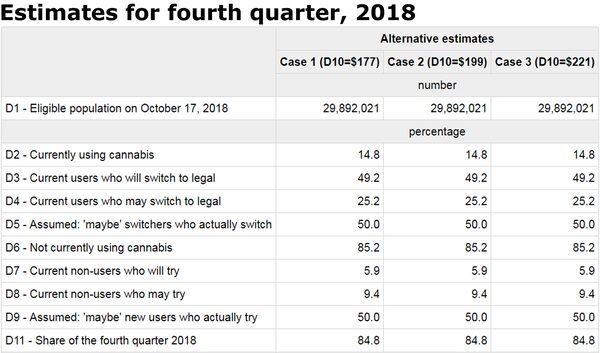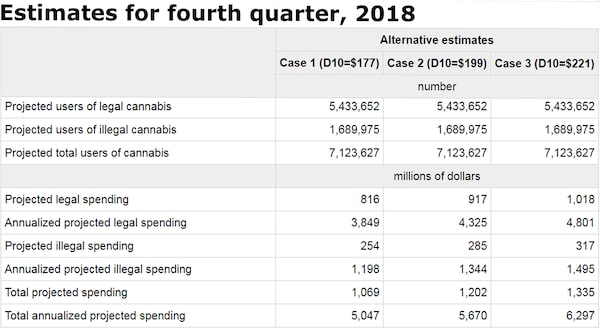Briefing highlights
- Estimating cannabis demand
- Markets at a glance
- What to watch for today
- Kors takes over Versace

Statisticians estimate potential fourth-quarter demand for legal marijuana in Canada at up to about $1-billion.
It's how they calculated it that can blow your mind.
(And, yes, I do know people don’t say that any more.)
It's this, and don't try it at a pot party: "Equation 1: Potential legal demand = D1 × {D2 × (D3 + D4 × D5) + D6 × (D7 + D8 × D9)} × D10 × D11."
That's from Statistics Canada, which is clearly investing a lot of effort into accounting for the legalization of recreational marijuana beginning in mid-October, which will affect everything from gross domestic product to inflation.
And it's not your average, everyday estimate because pot becomes legal on Oct. 17, meaning a fourth-quarter measure minus the first couple of weeks. Not only that, there are also illegal sales to still factor in.
Which brings us to the second estimate for the last three months of the year:
"Equation 2: Potential illegal demand = D1 × {D2 × (1 − D3 − D4 × D5)} × D10 × D11."
The bottom line is that the Statistics Canada model projects the number of buyers of legal cannabis at 5.4 million in the fourth quarter, with 1.7 million Canadians still buying illegally.
That puts potential spending at between $816-million and $1-billion for legal weed, and $254-million to $317-million for the forbidden stuff.
How Statistics Canada calculated this is fascinating.
“It is a matter of some speculation what the demand for cannabis will be after the substance becomes available for non-medical use,” the agency said, noting that it has estimated household spending on pot for decades “based largely” on what consumers say, and primarily for illegal recreational use.
"To what extent will the new legal market displace the long-existing illegal market and how large will new demand be, coming from consumers who are not presently using illegal products?" the group added.
"Definitive answers to these questions will start to become known after legal cannabis retail outlets have been open for a few weeks. With some stores opening in October, Statistics Canada expects to begin releasing monthly retail sales statistics from these stores in January, 2019."
For now, the agency said, it can still forecast how marijuana sales might fare, based on 11 factors, in an exercise that “may be of value to producers, retailers and federal and provincial regulators as they prepare for the legal sale of cannabis for non-medical purposes to adults.”
Some of the answers come from data gathered in a national cannabis survey, for the first and second quarters of 2018, which asked Canadians when, where and how they might buy it when it becomes legal.
Here’s a look at the model, which projects fourth-quarter demand using alternative estimates of the average amount spent by a Canadian who partakes.

Source: Statistics Canada
So, for example, the model takes into account the "total population" old enough to buy marijuana as per federal and provincial laws, about 29.9 million people in the D1 category. The table tells the rest of that story.
Statistics Canada also had to figure out spending. Without going through everything Statistics Canada sifted through, the agency noted this:
“Bringing the five categories together in a weighted average, the alternative estimates of the average amount spent by a Canadian cannabis user in the three-month period are D10 = $177, or $199, or $221.”

Source: Statistics Canada
Then, of course, you’ve got to account for the fact that a fourth-quarter measure wouldn’t be a typical one because of the mid-month implementation date:
"The eleventh factor is therefore D11 = 0.848, which is the number of days between Oct. 17 and Dec. 31 divided by the number of days between Oct. 1 and Dec. 31.
Also, Statistics Canada has no idea of seasonal behaviour at this point.
We may buy more gloves, tuques and scarves for winter, but who knows how people toke.
Finally, if you want to annualize the findings, as economists do and which will be a sign for producers and retailers, you’re looking at annualized fourth-quarter demand for legal marijuana at between $3.8-billion and $4.8-billion, illegal at $1.2-billion to $1.5-billion, and the total at more than $5-billion to $6.3-billion.
All of which tells you why statisticians don’t really have much time to smoke marijuana.
Read more
- Follow our special cannabis coverage
- David Berman, Tim Kiladze: Pot-com: Canadian cannabis stocks experience a second wave of marijuana madness
- Andrew Willis, Christina Pellegrini: U.S. cannabis firms eye market debut in Canada
- Christina Pellegrini, Marina Strauss: Beverage makers explore entries to Canadian cannabis sector
- Ian Brown: The oil barons of cannabis: Inside the illicit but lucrative world of ‘shatter’
- Dazed and confused: How legal cannabis will ‘artificially boost’ Canada’s economy
- Matt Lundy: Pot stocks flashing warning signs as investors drive valuations back to January peak
- 16 intriguing facts investors, consumers and producers should know about the pot market
- Canada seized 'the entire cannabis business’: Rock legend David Crosby on toking, Trudeau and the pot trade
- Denise Balkissoon: Do women really need their own weed?
- Don’t be surprised if your parents smoke pot when it’s legal
- Canada’s brewers want you to pay more in marijuana taxes
- From ‘busted!’ in 1972 to today’s $1-billion profit forecast: A deeper look at Canada’s legal marijuana market
Markets at a glance
Read more
- Follow our Inside the Market
What to watch for today
It’s a big day for Nike Inc. as it reports quarterly results for the first time after its spotlight deal with Colin Kaepernick.
"The recent controversy around Colin Kaepernick raised its profile in the wider media, however it is unlikely to affect its numbers that much," said CMC Markets chief analyst Michael Hewson.
"What might is the recent escalation in the trade rhetoric between the U.S. and China, particularly if tariffs get applied to goods that the company sells in one of its biggest markets in the coming months."
Read more
More news
- China says U.S. putting ‘knife to its neck’, hard to proceed on trade
- Michael Kors takes over luxury fashion icon Versace in $2-billion deal
 Michael Babad
Michael Babad